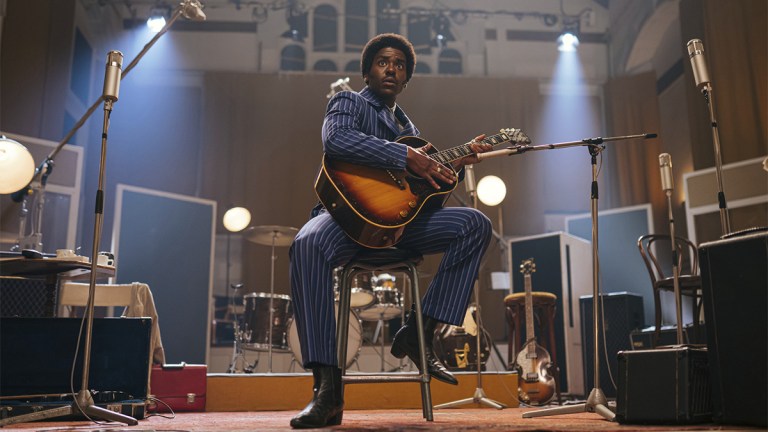Doctor Who’s Beatles Episode Messes With History in More Ways Than One
You’re not supposed to nitpick history stuff with Doctor Who, but…

The second episode of the newly relaunched Doctor Who is a haunting, contemplative story about what might happen if the world was robbed of its love of music. Like all good Who sci-fi premises, “The Devil’s Chord” takes something that is a given about human nature, and suggests our experience of life might be totally different without that thing. Just like “Blink” made us worry about trying to control our inherent reflex to bat our eyes, “The Devil’s Chord” makes us worried about how depressing and dystopian things would become without being able to hear a tune.
The episode also features a bootleg version of The Beatles, which should be a slam-dunk for Doctor Who, but isn’t. Instead, in creating a timey-wimey story about the death of music in a bizarro timeline, Who makes some blunders about why The Beatles became The Beatles.
Spoilers ahead.
While some Beatles and Who fans may want to get into the elephant in the room — that the actors playing the Beatles in this episode don’t really look like them — that’s not really the problem with this episode. There’s also small nitpicks one could really go after, like the fact that John Lennon shouldn’t be wearing those glasses at all, because he didn’t start rocking that style until after 1965, not 1963.
But, again, those would be fannish nitpicks, that are ultimately visual and superficial, and ultimately, petty. So, what’s a historical complaint about “The Devil’s Chord” that’s not petty? Well, the entire episode seems to misunderstand, or at least, ignore, the way the Beatles met, and became musicians in the first place. The thought experiment of a world without Beatles music is an interesting one, which was done surprisingly well by one-time Doctor Who writer Richard Curtis with his 2019 film Yesterday. But, what “The Devil’s Chord” does is split the difference: Instead of imagining a much worse version of the world without the Beatles, it created a version of the Beatles who suck.
The main conflict of “The Devil’s Chord” relies on the idea that in the 1920s, Maestro was released, and they absorbed so much music that the idea of music itself became less popular. This means that by 1963, we’re just watching the dying embers of music’s popularity among humankind. The Beatles and Cilla Black in this episode write and perform horrible songs, and have no real zest for the artmaking of songs at all. Everyone is embarrassed about their jobs as musicians, and all express desires to get regular careers instead. This is a fairly interesting cautionary tale about the idea that many in the world don’t consider the arts to be real work. But, in regard to John Lennon, Paul McCartney, George Harrison and Ringo Starr, it ignores how they became a band in the first place.
On July 6, 1957, a 15-year-old Paul McCartney met John Lennon, who was 16 at the time, while John was playing with this local band The Quarrymen. At the time, McCartney and Lennon were both obsessed with music, which is why they were playing music as literal teenagers. Eventually, an early version of The Beatles formed from this meeting, resulting in a line-up including McCartney, Lennon, George Harrison, Pete Best and Stuart Sutcliffe. This proto-version of The Beatles ended-up performing in clubs in Hamburg, Germany, well before they had a manager, or a record deal.
Here’s the crucial thing: The very early Beatles were deeply passionate about music, and it was only because of bootleg recordings of their early concerts that Brian Epstein — a man who had never managed a band — was so pumped to get them a record deal. “Mr. Epstein” is mentioned in “The Devil’s Chord,” but it seems impossible to imagine an exuberant version of him in this altered timeline in which nobody seems to care about music. Crucially, the Beatles were outsiders to the music industry in the early 1960s, and pushed against practices that were in place at that time. For example, many musical acts of that time exclusively released cover songs as their lead singles. The Beatles didn’t do that, opting to put out “Love Me Do” as their first single, an original song written by Lennon and McCartney.
In the Doctor Who version of all of this, the Beatles are bored session musicians, more or less taking direction from other people. What doesn’t make sense is thinking about how they got to this point. If music started to lose its appeal in the 1920s, it feels impossible the Beatles could have even met in 1957, much less have had the verve and swagger to play clubs in Hamburg, or attract a recording deal from Parlophone.
To put it another way, the boring, artificially repressed and cynical Beatles might exist in a timeline like this, but they would have never made their way into a recording studio. The story of The Beatles is compelling because of their passion for music, a passion that began well before they managed to become recording artists. So, a more realistic version of this episode would have simply resulted in the Doctor and Ruby arriving at EMI recording studios and discovering…nothing.
Doctor Who airs on the BBC in the UK and on Disney+ in the US.
